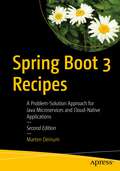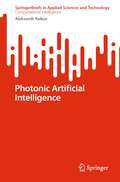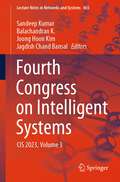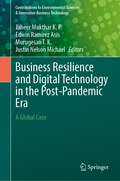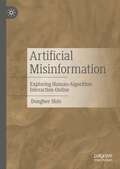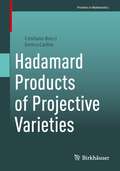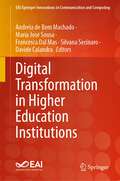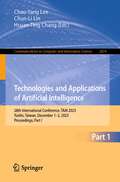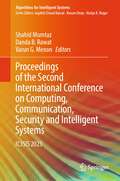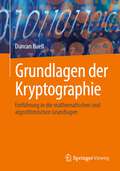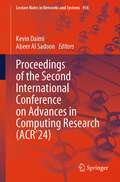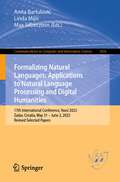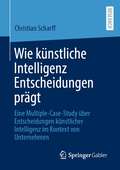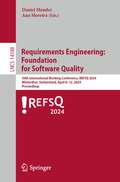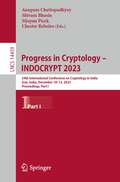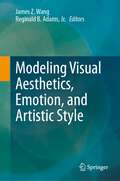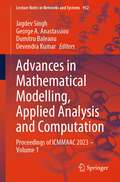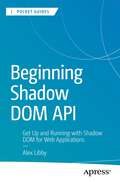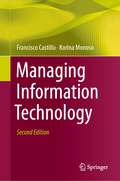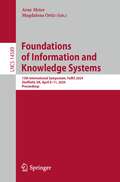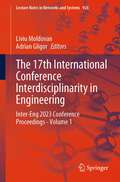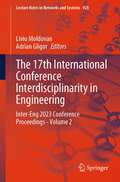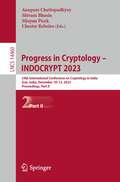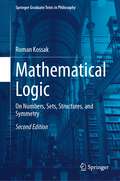- Table View
- List View
Spring Boot 3 Recipes: A Problem-Solution Approach for Java Microservices and Cloud-Native Applications
by Marten DeinumSolve all your Spring Boot 3 micro-framework problems using complete, real-world Java-based code snippets and examples inspired by various problems and corresponding solutions to those problems . When you start a new project, you’ll be able to copy the code and configuration files from this book, and then modify them for your own specific software programming needs. This can save you a great deal of work over creating a project from scratch.Spring Boot 3 Recipes has been revised to include new features like the new Spring Native, newly repackaged Spring Data, Spring Kafka for messaging and more on Kubernetes/deployment than in the previous edition. It includes Java 17 long term support code and Jakarta EE 9+ code as a base for Spring Boot 3. This handy code reference takes advantage of these things as it introduces you to VMWare's Spring Boot 3 and Spring Native. Quickly, it dives into code snippets on how to apply and integrate SpringBoot 3 with the Spring MVC web framework, web sockets and WebFlux for the rapid development of web applications, web services, microservices and more. You'll also get solutions to common problems with data persistence, integrating Spring Boot with batch processing, algorithmic programming via Spring Batch, and much more. These enable you to enhance or round out your web applications or microservices with a data and/or transaction-tier to boot. Other recipes cover topics such as using and integrating Boot with Spring's enterprise services, Spring Integration, testing, monitoring and more.At the end of the book, you'll have the code snippets and packages to deploy your Spring Boot-created microservices or applications on a cloud platform like Amazon using the popular Kubernetes container. Finally, this code reference is a must have for your Spring library. What You'll LearnGet reusable code recipes and snippets for the Spring Boot 3 micro-framework Discover how Spring Boot 3 integrates with other Spring APIs, tools, and frameworksAccess Spring MVC, web sockets and WebFlux for easier web developmentWork with microservices for web services development and integration with your Spring Boot applicationsAdd persistence and a data tier seamlessly to make your Spring Boot web application do moreIntegrate enterprise services via Spring Integration and Jakarta EE to create a more complex Java application using Spring BootWho This Book Is ForThis book is for experienced Java and Spring software programmers, developers.
Photonic Artificial Intelligence (SpringerBriefs in Applied Sciences and Technology)
by Aleksandr RaikovThis book addresses an attempt to create Photonic Artificial Intelligence (PAI) system based on optical technologies, which process signals continuously. PAI could help to overcome digital computer limits and almost zero out the machine learning time and AI inference. It helps to consider feelings, the chaos of thoughts, cognitive activity, and the transcendental states of the human mind in AI systems. The book also discusses new problems such as synthesizing new photonic materials, creating optical control systems, and connecting PAI systems with outside digital computers and holographic memory. The book is aimed at a wide range of readers, including postgraduates and researchers, interested in advanced AI by creating its new paradigm, which can help to overcome traps of traditional AI development.
Fourth Congress on Intelligent Systems: CIS 2023, Volume 3 (Lecture Notes in Networks and Systems #865)
by Sandeep Kumar Balachandran K. Joong Hoon Kim Jagdish Chand BansalThis book is a collection of selected papers presented at the Fourth Congress on Intelligent Systems (CIS 2023), organized by CHRIST (Deemed to be University), Bangalore, India, under the technical sponsorship of the Soft Computing Research Society, India, during September 4–5, 2023. It includes novel and innovative work from experts, practitioners, scientists, and decision-makers from academia and industry. It covers topics such as the Internet of Things, information security, embedded systems, real-time systems, cloud computing, big data analysis, quantum computing, automation systems, bio-inspired intelligence, cognitive systems, cyber-physical systems, data analytics, data/web mining, data science, intelligence for security, intelligent decision-making systems, intelligent information processing, intelligent transportation, artificial intelligence for machine vision, imaging sensors technology, image segmentation, convolutional neural network, image/video classification, soft computing for machine vision, pattern recognition, human-computer interaction, robotic devices and systems, autonomous vehicles, intelligent control systems, human motor control, game playing, evolutionary algorithms, swarm optimization, neural network, deep learning, supervised learning, unsupervised learning, fuzzy logic, rough sets, computational optimization, and neuro-fuzzy systems.
Business Resilience and Digital Technology in the Post-Pandemic Era: A Global Case (Contributions to Environmental Sciences & Innovative Business Technology)
by Jaheer Mukthar K.P. Edwin Ramirez Asis Murugesan T. K. Justin Nelson MichaelThis book throws a light on sustainable perspectives of how business entities experienced the turbulent environment in the light of pandemic. The post-pandemic era is characterized by the radical and dramatic changes in the business model, corporate strategies and digital technology. This book provides the academicians, research scholars and corporate professionals with a thought-provoking forum to discuss and deliberate the major trends, opportunities and issues of business entity from the outlook of business resilience, corporate strategy and digital technology in the light of post-pandemic era. The book also suggests suitable measures and strategies for the sustainable development of business entities.
Artificial Misinformation: Exploring Human-Algorithm Interaction Online
by Donghee ShinThis book serves as a guide to understanding the dynamics of AI in human contexts with a specific focus on the generation, sharing, and consumption of misinformation online. How do humans and AI interact? How is AI shaping our understanding of ourselves and our societies? What are the interaction mechanisms that govern how humans and algorithms contribute to misinformation online? And how do we bridge the gap between ethical considerations and practical realities to make responsible, reliable systems? Exploring these questions, the book empowers humans to make AI design choices that allow them meaningful control over AI and the online sphere. Calling for an interdisciplinary approach toward human-misinformation algorithmic interaction that focuses on building methods and tools that robustly deal with complex psychological/social phenomena, the book offers a compelling insight into the future of AI-based society.
Hadamard Products of Projective Varieties (Frontiers in Mathematics)
by Cristiano Bocci Enrico CarliniThis monograph deals with the Hadamard products of algebraic varieties. A typical subject of study in Algebraic Geometry are varieties constructed from other geometrical objects. The most well-known example is constituted by the secant varieties, which are obtained through the construction of the join of two algebraic varieties, which, in turn, is based on the operation of summing two vectors. However, other constructions are possible through a change of the basic operation. One remarkable case is based on the Hadamard product of two vectors. While secant varieties of algebraic varieties have been studied extensively and systematically, the same is not yet true for the Hadamard products of algebraic varieties. This monograph aims to bridge this gap in the literature.The topic is presented in a self-contained manner, and it is accessible to all readers with sound knowledge of Commutative Algebra and Algebraic Geometry. Both experienced researchers and students can profit from this monograph, which will guide them through the subject. The foundational aspects of the Hadamard products of algebraic varieties are covered and some connections both within and outside Algebraic Geometry are presented. The theoretical and algorithmic aspects of the subject are considered to demonstrate the effectiveness of the results presented. Thus, this monograph will also be useful to researchers in other fields, such as Algebraic Statistics, since it provides several algebraic and geometric results on such products.
Digital Transformation in Higher Education Institutions (EAI/Springer Innovations in Communication and Computing)
by Andreia de Bem Machado Maria José Sousa Francesca Dal Mas Silvana Secinaro Davide CalandraThis book analyzes digital technologies being used in the teaching-learning process. The authors show how the use of AI in higher education can provide personalized education through the automation of administrative teaching tasks, software programs that favor the detection of topics that need reinforcement in the classroom, the guidance and support of students outside the classroom, and the use of data intelligently to teach and support students. In addition, the authors show how to further personalize education with the use of augmented reality, adaptive platforms, intelligent tutor systems, Chatbots, adaptive learning, computer aided instruction, MOOCs, and robotics. The authors answer questions such as: What sustainable educational technologies can be used in the teaching-learning process; How can Blockchain technology and AI be applied in higher education; How can the metaverse be applied in virtual learning environments? The book is relevant to researchers, professionals, andstudents interested in technology and education.
Technologies and Applications of Artificial Intelligence: 28th International Conference, TAAI 2023, Yunlin, Taiwan, December 1–2, 2023, Proceedings, Part I (Communications in Computer and Information Science #2074)
by Chao-Yang Lee Chun-Li Lin Hsuan-Ting ChangThis book constitutes the proceedings of the 28th International Conference on Technologies and Applications of Artificial Intelligence, TAAI 2023, which was held in Yunlin, Taiwan, during December 1–2, 2023. `The 35 full papers and 12 short papers included in this book were carefully reviewed and selected from 193 submissions. The TAAI 2023 provides a platform for experts and scholars from domestic and international universities, research units, and industries to exchange AI technologies and application results.
Proceedings of the Second International Conference on Computing, Communication, Security and Intelligent Systems: IC3SIS 2023 (Algorithms for Intelligent Systems)
by Shahid Mumtaz Danda B. Rawat Varun G. MenonThis book presents the best-selected research papers presented at the Second International Conference on Computing, Communication, Security & Intelligent Systems (IC3SIS 2023), organized by SCMS School of Engineering and Technology, Kochi, on July 06–07, 2023. It discusses the latest technologies in communication and intelligent systems, covering various areas of computing, such as advanced computing, communication and networking, intelligent systems and analytics, 5G and IoT, soft computing, and cybersecurity in general. Featuring work by leading researchers and technocrats, the book serves as a valuable reference resource for young researchers, academics, and industry practitioners.
Grundlagen der Kryptographie: Einführung in die mathematischen und algorithmischen Grundlagen
by Duncan BuellDie Kryptographie, wie sie in diesem Jahrhundert betrieben wird, ist stark mathematisch geprägt. Aber sie hat auch ihre Wurzeln in dem, was rechnerisch machbar ist.In diesem einzigartigen Lehrbuch werden die Theoreme der Mathematik gegen die Machbarkeit von Berechnungen abgewogen. Kryptografie ist etwas, das man tatsächlich "macht", kein mathematisches Spiel, über das man Theoreme beweist. Es gibt tiefgründige Mathematik; es gibt einige Theoreme, die bewiesen werden müssen; und es besteht die Notwendigkeit, die brillante Arbeit derjenigen anzuerkennen, die sich auf die Theorie konzentrieren. Auf der Ebene eines Grundstudiums sollte der Schwerpunkt jedoch zunächst darauf liegen, die Algorithmen zu kennen und zu verstehen und zu wissen, wie sie zu implementieren sind, und sich auch bewusst zu machen, dass die Algorithmen sorgfältig implementiert werden müssen, um die "einfachen" Wege zum Brechen der Kryptografie zu vermeiden. Dieser Text deckt die algorithmischen Grundlagen ab und wird durch Kernmathematik und Arithmetik ergänzt.
Proceedings of the Second International Conference on Advances in Computing Research (Lecture Notes in Networks and Systems #956)
by Kevin Daimi Abeer Al SadoonThis book concentrates on advances in research in the areas of computational intelligence, cybersecurity engineering, data analytics, network and communications, cloud and mobile computing, and robotics and automation. The Second International Conference on Advances in Computing Research (ACR’24), June 3–5, 2024, in Madrid, brings together a diverse group of researchers from all over the world with the intent of fostering collaboration and dissemination of the advances in computing technologies. The conference is aptly segmented into six tracks to promote a birds-of-the-same-feather congregation and maximize participation. It introduces the concepts, techniques, methods, approaches, and trends needed by researchers, graduate students, specialists, and educators for keeping current and enhancing their research and knowledge in these areas.
Formalizing Natural Languages: 17th International Conference, NooJ 2023, Zadar, Croatia, May 31–June 2, 2023, Revised Selected Papers (Communications in Computer and Information Science #1816)
by Anita Bartulović Linda Mijić Max SilberzteinThis book constitutes the refereed proceedings of the 17th International Conference on Formalizing Natural Languages with NooJ 2023 and Its Natural Language Processing Applications, NooJ 2023, held in Zadar, Croatia, during May 31–June 2, 2023. The 19 full papers included in this book were carefully reviewed and selected from 64 submissions. They were organized in topical sections as follows: morphological and lexical resources; syntactic and semantic resources; corpus linguistics and discourse analysis; and natural language processing applications.
Wie künstliche Intelligenz Entscheidungen prägt: Eine Multiple-Case-Study über Entscheidungen künstlicher Intelligenz im Kontext von Unternehmen
by Christian ScharffViele Organisationstheorien schließen Technik aus der sozialen Welt aus. Dies wird durch lernfähige Algorithmen infrage gestellt, deren Output sich nicht vollständig auf Menschen zurückrechnen lässt. Es ist deshalb notwendig, die Beziehung von Organisation und künstlicher Intelligenz ergebnisoffen zu untersuchen und zu erklären. Das vorliegende Buch analysiert zu diesem Zweck auf Grundlage einer Multiple-Case-Study, auf welche Weise, aus welchen Gründen und mit welchen Folgen künstliche Intelligenz an den Entscheidungen von Unternehmen beteiligt ist. Es stellt sich heraus, dass die Technik als Entscheidungsträger aktiv an Organisationen teilnehmen und deren strukturelles Fundament prägen kann. Dabei handelt es sich jedoch nur um eine von drei Erscheinungsformen künstlicher Intelligenz. Inwieweit KI-Anwendungen tatsächlich Gelegenheit erhalten, Entscheidungen zu treffen, bestimmen Organisationen nach eigenen Maßgaben.
Requirements Engineering: 30th International Working Conference, REFSQ 2024, Winterthur, Switzerland, April 8–11, 2024, Proceedings (Lecture Notes in Computer Science #14588)
by Daniel Mendez Ana MoreiraThis book constitutes the refereed proceedings of the 30th International Working Conference on Requirements Engineering: Foundation for Software Quality, REFSQ 2024, held in Winterthur, Switzerland, during April 8–12, 2024.The 14 full papers and 8 short papers included in this book were carefully reviewed and selected from 59 submissions. They are organized in topical sections as follows: quality models for requirements engineering; quality requirements; explainability with and in requirements engineering; artificial intelligence for requirements engineering; natural language processing for requirements engineering; requirements engineering for artificial intelligence; crowd-based requirements engineering; and emerging topics and challenges in requirements engineering.
Progress in Cryptology – INDOCRYPT 2023: 24th International Conference on Cryptology in India, Goa, India, December 10–13, 2023, Proceedings, Part I (Lecture Notes in Computer Science #14459)
by Anupam Chattopadhyay Shivam Bhasin Stjepan Picek Chester RebeiroThe two-volume proceedings constitutes the refereed proceedings of the 24th International Conference on Progress in Cryptology, INDOCRYPT 2023, Goa, India, in December 2023. The 26 full papers were carefully reviewed and selected from 74 submissions. They are organized in topical sections as follows: Part One: Symmetric-key cryptography, Hash functions, Authenticated Encryption Modes; Elliptic curves, Zero-knowledge proof, Signatures; Attacks.Part Two: Secure computation, Algorithm hardness, Privacy; Post-quantum cryptography.
Digitale Werbung in der Post-Cookie-Ära: Gezielte Kampagnenplanung entlang der Customer Journey
by Alexander Schwarz-Musch Alexander Tauchhammer Bernhard GuetzDieses Buch erklärt, wie Unternehmen ihre Onlinekampagnen erfolgreich planen und umsetzen können – auch nach dem Ende der Third-Party-Cookies. Kampagnen auf Social-Media-Plattformen, in Suchmaschinen und mittels Display-Werbung können nach wie vor effektiv sein, wenn potenzielle Kund:innen gezielt angesprochen werden. Die Autoren zeigen, wie das auch ohne Cookies funktioniert: Die Entwicklung einer „Minimum Viable Persona“ und die Definition von Kampagnengruppen entlang der Customer Journey spielen dabei zentrale Rollen. Für jeden Touchpoint auf dem Weg zum Kaufabschluss müssen Etappenziele definiert werden, wodurch Effektivität und Effizienz der Maßnahmen leicht überprüft werden können.Ein Werk für Marketingverantwortliche, die nach Lösungen in der Post-Cookie-Ära suchen, um ihre Zielgruppen weiterhin ohne Streuverluste zu erreichen.
Modeling Visual Aesthetics, Emotion, and Artistic Style
by James Z. Wang Reginald B. Adams Jr.Modeling Visual Aesthetics, Emotion, and Artistic Style offers a comprehensive exploration of the increasingly significant topic of the complex interplay between human perception and digital technology. It embodies the cumulative knowledge and efforts of a wide array of active researchers and practitioners from diverse fields including computer vision, affective computing, robotics, psychology, data mining, machine learning, art history, and movement analysis. This volume seeks to address the profound and challenging research questions related to the computational modeling and analysis of visual aesthetics, emotions, and artistic style, vital components of the human experience that are increasingly relevant in our digitally connected world. The book's vast scope encompasses a broad range of topics. The initial chapters lay a strong foundation with background knowledge on emotion models and machine learning, which then transitions into exploring social visual perception in humans and its technological applications. Readers will uncover the psychological and neurological foundations of social and emotional perception from faces and bodies. Subsequent sections broaden this understanding to include technology's role in detecting discrete and subtle emotional expressions, examining facial neutrality, and including research contexts that involve children as well as adults. Furthermore, the book illuminates the dynamic intersection of art and technology, the language of photography, the relationship between breath-driven robotic performances and human dance, and the application of machine learning in analyzing artistic styles. This book sets itself apart with its unique multidisciplinary approach, encouraging collaboration across related domains. Packed with comprehensive tutorials, theoretical reviews, novel methodologies, empirical investigations, and comparative analyses, the book offers a rich combination of knowledge and methodologies. The book's focus on cutting-edge research not only presents the latest developments in the field but also illuminates potential paths that can lead to significant advancements in computer and robotic applications.
Advances in Mathematical Modelling, Applied Analysis and Computation: Proceedings of ICMMAAC 2023 – Volume 1 (Lecture Notes in Networks and Systems #952)
by Jagdev Singh George A. Anastassiou Dumitru Baleanu Devendra KumarThis book gathers selected research articles presented in the “6th International Conference on Mathematical Modelling, Applied Analysis and Computation (ICMMAAC)”, held at JECRC University, Jaipur, during August 3–5, 2023. This book is focused on articles dealing with necessary theory and techniques in a balanced manner, and contributes towards solving mathematical problems arising in physics, engineering, chemistry, biological systems, medicine, networking system, control systems, environmental sciences, social issues of current interest and more. Annually held since 2018, the ICMMAAC conference aimed, in particular, to foster cooperation among practitioners and theoreticians in these fields. This proceedings is an invaluable resource for researchers, academicians and professionals associated or interested in current advances in different aspects of mathematical modelling, computational algorithms and analysis necessary for handling real-world problems.
Beginning Shadow DOM API: Get Up and Running with Shadow DOM for Web Applications (Apress Pocket Guides)
by Alex LibbyLeverage the power of the Shadow DOM API to quickly create encapsulated code that keeps markup and styles separate within websites. Using little more than a text editor or free software, this project-oriented book simplifies the process of creating and manipulating the Shadow DOM API code in the browser for websites or online applications. You'll use a starting toolset to develop future projects, incorporate them into an existing workflow, and allow them to simplify complex components. This makes them more robust and less brittle when used in websites. You'll also see that websites do not have to convert the whole work process immediately; you can incorporate as little or as much as needed of the API, and build on this as your skills develop. We live in an age where speed and simplicity are of the essence. Beginning Shadow DOM API shows you the perfect way to create encapsulated code that can run in multiple frameworks with a minimum of fuss.You You'll LearnImplement the Shadow DOM API in a projectGain an appreciation of pointers using the Shadow DOM APIManage issues and security when using the Shadow DOM APIMake components and code more reusable, while maintaining desired stylingWho This Book Is ForWebsite developers who are already familiar with frameworks that Shadow DOM API, but do not want to have to use the heavy weight of a full-sized framework to add features such as DOM encapsulation to their code.
Managing Information Technology
by Francisco Castillo Korina MonosoThere are two different, interdependent components of IT that are important to a CIO: strategy, which is long-term; and tactical and operational concerns, which are short-term. Based on this distinction and its repercussions, this book clearly separates strategy from day-to-day operations and projects from operations – the two most important functions of a CIO.It starts by discussing the ideal organization of an IT department and the rationale behind it, and then goes on to debate the most pressing need – managing operations. It also explains some best industry standards and their practical implementation, and discusses project management, again highlighting the differences between the methodologies used in projects and those used in operations. A special chapter is devoted to the cutover of projects into operations, a critical aspect seldom discussed in detail. Other chapters touch on the management of IT portfolios, project governance, as well as agile project methodology,how it differs from the waterfall methodology, and when it is convenient to apply each. In this second edition, besides a number of corrections and updates throughout the text, chapter 8 on “Agile Project Management” replaces the former chapter 8 completely, and chapter 10 on “IT Security” has been newly introduced as this topic has become more and more important for both management and operations during the last six years.Taking the fundamental principles of IT service management and best practices in project management, the book offers a single, seamless reference for IT managers and professionals. It is highly practical, explaining how to apply these principles based on the author’s extensive experience in industry.
Foundations of Information and Knowledge Systems: 13th International Symposium, FoIKS 2024, Sheffield, UK, April 8–11, 2024, Proceedings (Lecture Notes in Computer Science #14589)
by Arne Meier Magdalena OrtizThis LNCS conference volume constitutes the proceedings of the 13th International Symposium, FoIKS 2024, in Sheffield, UK, in April 2024. The 18 full papers together with 3 short papers included in this volume were carefully reviewed and selected from 42 submissions.The Symposium focuses on fundamental aspect of information and knowledge systems, including submissions that apply ideas, theories, or methods from specific disciplines to information and knowledge systems. Examples of such disciplines are discrete mathematics, logic and algebra, model theory, databases, information theory, complexity theory, algorithmics and computation, statistics, and optimization.
The 17th International Conference Interdisciplinarity in Engineering: Inter-Eng 2023 Conference Proceedings - Volume 1 (Lecture Notes in Networks and Systems #926)
by Liviu Moldovan Adrian GligorThis book contains research papers that were accepted for presentation at the 17th International Conference on Interdisciplinarity in Engineering—INTER-ENG 2023, which was held on 5–6 October 2023, in the city of Târgu Mureș, Romania. The general scope of the conference “Towards transition for a more competitive European industry in a smart, safe and sustainable future” is proposing a new approach related to the development of a new generation of smart factories grounded on the manufacturing and assembly process digitalization. It is related to advance manufacturing technology, lean manufacturing, sustainable manufacturing, additive manufacturing, manufacturing tools and equipment. It is a leading international professional and scientific forum of great interest for engineers and scientists who can read in this book research works contributions and recent developments as well as current practices in advanced fields of engineering.
The 17th International Conference Interdisciplinarity in Engineering: Inter-Eng 2023 Conference Proceedings - Volume 2 (Lecture Notes in Networks and Systems #928)
by Liviu Moldovan Adrian GligorThis book contains research papers that were accepted for presentation at the 17th International Conference on Interdisciplinarity in Engineering—INTER-ENG 2023, which was held on 5–6 October 2023, in the city of Târgu Mureș, Romania. The general scope of the conference “Towards transition for a more competitive European industry in a smart, safe and sustainable future” is proposing a new approach related to the development of a new generation of smart factories grounded on the manufacturing and assembly process digitalization. It is related to advance manufacturing technology, lean manufacturing, sustainable manufacturing, additive manufacturing, manufacturing tools and equipment. It is a leading international professional and scientific forum of great interest for engineers and scientists who can read in this book research works contributions and recent developments as well as current practices in advanced fields of engineering.
Progress in Cryptology – INDOCRYPT 2023: 24th International Conference on Cryptology in India, Goa, India, December 10–13, 2023, Proceedings, Part II (Lecture Notes in Computer Science #14460)
by Anupam Chattopadhyay Shivam Bhasin Stjepan Picek Chester RebeiroThe two-volume proceedings constitutes the refereed proceedings of the 24th International Conference on Progress in Cryptology, INDOCRYPT 2023, Goa, India, in December 2023. The 26 full papers were carefully reviewed and selected from 74 submissions. They are organized in topical sections as follows: Part One: Symmetric-key cryptography, Hash functions, Authenticated Encryption Modes; Elliptic curves, Zero-knowledge proof, Signatures; Attacks. Part Two: Secure computation, Algorithm hardness, Privacy; Post-quantum cryptography.
Mathematical Logic: On Numbers, Sets, Structures, and Symmetry (Springer Graduate Texts in Philosophy #4)
by Roman KossakThis textbook is a second edition of the successful, Mathematical Logic: On Numbers, Sets, Structures, and Symmetry. It retains the original two parts found in the first edition, while presenting new material in the form of an added third part to the textbook. The textbook offers a slow introduction to mathematical logic, and several basic concepts of model theory, such as first-order definability, types, symmetries, and elementary extensions. Part I, Logic Sets, and Numbers, shows how mathematical logic is used to develop the number structures of classical mathematics. All necessary concepts are introduced exactly as they would be in a course in mathematical logic; but are accompanied by more extensive introductory remarks and examples to motivate formal developments. The second part, Relations, Structures, Geometry, introduces several basic concepts of model theory, such as first-order definability, types, symmetries, and elementary extensions, and shows how they are usedto study and classify mathematical structures. The added Part III to the book is closer to what one finds in standard introductory mathematical textbooks. Definitions, theorems, and proofs that are introduced are still preceded by remarks that motivate the material, but the exposition is more formal, and includes more advanced topics. The focus is on the notion of countable categoricity, which analyzed in detail using examples from the first two parts of the book. This textbook is suitable for graduate students in mathematical logic and set theory and will also be of interest to mathematicians who know the technical aspects of the subject, but are not familiar with its history and philosophical background.
